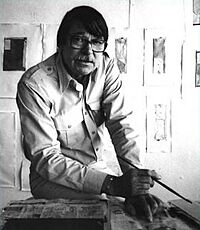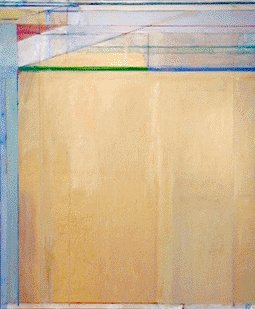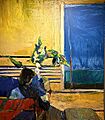Richard Diebenkorn facts for kids
Quick facts for kids
Richard Diebenkorn
|
|
|---|---|

Richard Diebenkorn in 1986
|
|
| Born | April 22, 1922 Portland, Oregon, US
|
| Died | March 30, 1993 (aged 70) |
| Known for | Painting |
| Movement | Bay Area Figurative Movement, abstract expressionism, Color Field painting, lyrical abstraction |
Richard Diebenkorn (born April 22, 1922 – died March 30, 1993) was an important American painter and printmaker. His early artwork was part of a style called abstract expressionism. He was also a key artist in the Bay Area Figurative Movement in the 1950s and 1960s.
Later in the 1960s, he started creating a long series of geometric, abstract paintings. These were known as the Ocean Park paintings. They helped him become famous around the world.
Contents
Richard Diebenkorn's Early Life
Richard Clifford Diebenkorn Jr. was born in Portland, Oregon, on April 22, 1922. When he was two years old, his family moved to San Francisco, California. From a very young age, he loved to draw all the time.
In 1940, Diebenkorn started studying at Stanford University. There, he met two important art teachers. One was Victor Arnautoff, who taught him how to paint with oil. The other was Daniel Mendelowitz, who shared his love for the art of Edward Hopper. You can see Hopper's influence in Diebenkorn's early realistic paintings.
While at Stanford, Diebenkorn visited the home of Sarah Stein. She was related to the famous writer Gertrude Stein. There, he saw paintings by European modern artists like Paul Cézanne, Pablo Picasso, and Henri Matisse for the first time.
Art Studies and World War II
At Stanford, Diebenkorn also met Phyllis Antoinette Gilman, who would become his wife. They married in 1943 and had two children, Gretchen and Christopher.
World War II interrupted Diebenkorn's studies at Stanford. He joined the United States Marine Corps in 1943 and served until 1945. Even while in the Marines, he kept studying art. He learned more about European modern art at the University of California, Berkeley. Later, while stationed in Virginia, he visited art museums in big cities like Washington, D.C., and New York City.
This allowed him to see paintings by famous artists such as Pierre Bonnard, Henri Matisse, and Pablo Picasso. He also saw the new abstract paintings by artists in New York, especially Robert Motherwell. This inspired Diebenkorn to start trying out abstract painting himself.
In 1945, Diebenkorn was supposed to go to Japan. But the war ended, and he was discharged. He returned home to the Bay Area in California.
Developing His Art Style
In the late 1940s and early 1950s, Diebenkorn lived and worked in different places. These included San Francisco, Sausalito, New Mexico, and Illinois. During this time, he developed his own unique style of abstract expressionist painting.
After World War II, the art world's attention shifted from Paris to the United States. In 1946, Diebenkorn enrolled at the California School of Fine Arts (CSFA) in San Francisco. This school was known for its strong abstract expressionist style. He taught there from 1947 to 1950. He was influenced by other artists like Clyfford Still and Willem de Kooning. Diebenkorn quickly became a leading abstract expressionist artist on the West Coast.
From Abstract to Figurative Art
In 1953, Diebenkorn moved back to the San Francisco Bay Area. He taught at the California College of Arts and Crafts from 1955 to 1958. He settled in Berkeley and lived there until 1966.
During these years, Diebenkorn changed his art style. He moved away from strict abstract expressionism. He started painting in a more realistic way, focusing on figures and scenes. By the mid-1950s, he became an important figurative painter. His style mixed the ideas of Henri Matisse with abstract expressionism.
Diebenkorn, along with artists like Elmer Bischoff and David Park, helped bring back figurative painting. This movement was called the Bay Area Figurative Movement. He painted interiors, landscapes, still lifes, and people.
During this time, Diebenkorn's art became more successful. He had many solo shows and was part of group exhibitions. In 1960, a big show of his work was held at the Pasadena Art Museum.
Exploring Printmaking
In 1961, while teaching in Los Angeles, Diebenkorn learned about printmaking. He tried a technique called drypoint. He also worked on a series of prints at the Tamarind Lithography Workshop.
When he returned to Berkeley, Diebenkorn seriously explored drypoint and printmaking. He worked with Kathan Brown at her new printing press, Crown Point Press. In 1965, Crown Point Press published his first collection of prints, 41 Etchings Drypoints. He continued to create prints with Crown Point Press almost every year until 1992.
Diebenkorn also taught at several colleges during these years. These included the San Francisco Art Institute and UCLA.
Artist-in-Residence at Stanford
From 1963 to 1964, Diebenkorn was the first artist-in-residence at Stanford University. This meant his main job was to create art in a studio provided by the university. Students could visit him during certain times. He made many drawings during this time.
In 1964 and 1965, Diebenkorn traveled through Europe. He visited museums in the Soviet Union to see paintings by Matisse. When he returned to California, his new paintings showed everything he had learned.
The Ocean Park Series
In 1966, Diebenkorn moved to Santa Monica, California. He became a professor at UCLA. He also got a studio in Santa Monica.
In late 1966, he returned to abstract painting. This time, his style was geometric and very personal. He started his most famous work, the Ocean Park series, in 1967. He continued this series for 18 years, creating about 135 paintings.
These large abstract paintings were inspired by the views from his studio window and the landscape around Santa Monica. The series is named after the Ocean Park community where his studio was located. Diebenkorn retired from UCLA in 1973. The Ocean Park series connected his earlier abstract works with other styles like color field painting.
Later Years and Legacy
In 1986, Diebenkorn decided to leave Santa Monica. In 1988, he and his wife settled in Healdsburg, California, where he built a new studio.
In 1989, he began to have serious health problems related to heart disease. His poor health made it hard for him to complete large paintings. However, he still created prints, drawings, and smaller paintings. In 1990, he made a series of etchings for a special book of poems by W. B. Yeats.
Richard Diebenkorn passed away in Berkeley on March 30, 1993, due to complications from a lung condition.
Art Exhibitions
Diebenkorn had his first art show in San Francisco in 1948. A major show of his work happened in 1976–77 at the Albright–Knox Art Gallery in New York. This show then traveled to other cities.
In 2012, an exhibition called Richard Diebenkorn: The Ocean Park Series traveled to museums in Texas, California, and Washington, D.C.
More recently, there have been important shows in the San Francisco Bay Area. These include Diebenkorn: The Berkeley Years in 2013. Also, a major show called Matisse/Diebenkorn in 2017 highlighted how Matisse influenced Diebenkorn's art.
Where to See His Art
You can find Richard Diebenkorn's artwork in many public collections. These include:
- New Mexico Museum of Art
- Honolulu Museum of Art
- Art Institute of Chicago
- Baltimore Museum of Art
- Corcoran Gallery of Art
- de Young Museum in San Francisco
- Los Angeles County Museum of Art
- Minneapolis Institute of Art
- Museum of Fine Arts, Houston
- The Phillips Collection in Washington, D.C.
- San Francisco Museum of Modern Art
- Solomon R. Guggenheim Museum in New York
- Whitney Museum of American Art in New York
The Iris & B. Gerald Cantor Center for Visual Arts at Stanford University has 29 of Diebenkorn's sketchbooks. They also have a collection of his paintings and other works on paper.
Awards and Recognition
In 1978, Richard Diebenkorn received The Edward MacDowell Medal. This award is given for great contributions to American culture.
In 1991, he was given the National Medal of Arts. This is one of the highest honors for artists in the United States. He was also elected into the National Academy of Design in 1979.
Images for kids
-
Girl with Plant (1960), The Phillips Collection




